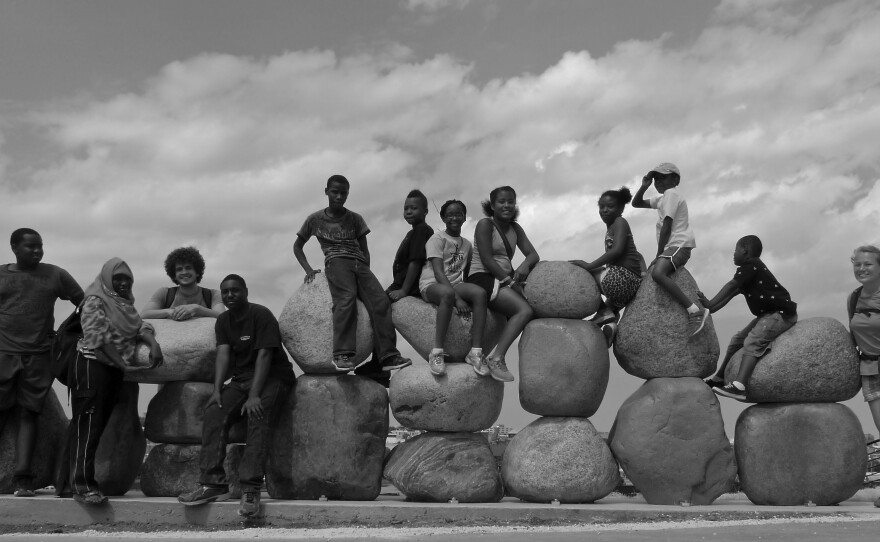A blend of public/private partnerships have transformed a bleak, blighted Menomonee Valley. Monday, the Public Policy Forum released a report detailing what we can learn – and possibly replicate – in other large scale redevelopment projects. Some valley neighbors share their perspectives.
Dr. Michele Bria knows the history of the Menomonee Valley. It was once filled with industry. Bria works in the adjacent Clarke Square neighborhood.

“Clark Square, back in the late 1800s, was really founded because our workers were walking into the valley for work – they called it the Tin Bucket Line," Bria says. "They’d have their lunch buckets, go down into the valley work and come work and so our neighborhood was very much settled because people came to the city to get the jobs in the valley and settled here."
Bria leads the organization Journey House. It came to life 45 years ago to help neighbors, as industry in the valley perished and jobs disappeared.
“Through our Urban Careers Institute, we provide case management, job training and placement and financial education,” Bria says.
For a time, the valley stood abandoned and polluted, until partnerships began forming between government and business.
Public funds helped remediate some of the land and pave roads. A few new employers bought tracts.
Bria says cornerstone employers such as Potawatomi and Palermo’s have helped pump life back into the neighborhood. Yet she says – and so does the Public Policy Forum report, that a disconnect exists, between some new companies in the Valley and potential nearby workers.
“I would say the employers such as Potawatomi, Palermo's and formerly Cargill, because they had such a high volume of different kinds of levels of jobs, those employers were very easy for us to work with and match job skills," Bria says. "As higher job skills are needed that becomes more difficult,"
So, although the Public Policy Forum report is important, Bria says, “the work is not done – it’s just a template and we’re continuing to take those ingredients of leadership and intergovernmental relationships making those different connections.”

Martha Cuenca and her husband bought a home five years ago, very close to the Urban Ecology Center and above bridge one of Three Bridges Park. Both are deemed major new assets of the Menomonee Valley renaissance.
Cuenca says as the park and center took root, she believed this would be a safer, healthier neighborhood to raise their children. They’re ages five, eight and nine. The mom speaks English but feels more comfortable having a translator.
“In the time since she’s moved here, she said the neighborhood has gotten cleaner, there’s even less crime – she feels like there are more things for her kids that are fun and they’re outside and many of them are free,” Cuenca says through a translator.
Cuenca says that sense of safety motivated her to start a neighborhood walking group, while another neighbor launched a biking club.
One of Tatiana Maida’s hats is managing an obesity program with the 16th Street Community Health Center. She thinks Three Bridges Park contains untapped potential.
“When you come here, there is the feeling of safety; there is the feeling of diversity. It’s beautiful to see Asian people, Black people, Caucasians, Latinos," Maida says. "And when you see that diversity that makes you feel safer too. I think the only issue is for more people to get to know and enjoy this space. But that takes time – they will find the joy of physical activity and that’s what you need, that joy."
Wayne Adamczyk grew up in this neighborhood. “I’ve been fishing the river since I was 10 years old, behind Miller and all that. I fished it this year. It’s a great stream, it’s a hidden gem,” Adamczyk says.
Adamczyk helped plant hundreds of trees along the Hank Aaron Trail long before Three Bridges Park grew up to meet it.

"It’s more than a diamond in the rough, it’s becoming something more positive. There’s a simple mural on the back of the salt company,” Adamczyk says.
The large colorful mural depicts wildlife native to Wisconsin – from deer to wolf. Adamczyk says for years the company wall was splashed with graffiti, now, nobody has touched the mural.
Still, he admits, it has sometimes taken determination to stay put. While his small home is perfectly kept and landscaped; a number of properties around him stand vacant, “one next door, one directly across the street and one just got condemned,” he says.
When I ask how he feels about the revitalizing valley, Adamczyk simply says, “it’s okay.” In the same breath he points out his favorite part of Three Bridge’s Park, “I like this bridge, you’ve got to come here at night to see all the under-lighting – because the rails underneath are lit. There’s no lighting from the top.”
The nighttime glow might not be included in the Menomonee Valley report – but it likely numbers among the intangibles of the valley’s revitalization.









